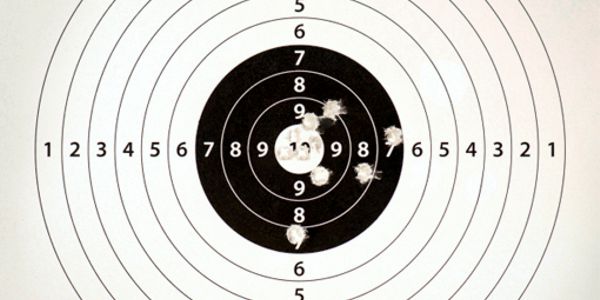In the martial arts world, weapons training helps develop qualities that are both advanced and potent. The practice of extending one’s body outward by using an implement, and increasing one’s impact power through the use of weapons, demands greater control and aids in the development of superior focus, mobility and dexterity. But while the use of various sticks and staves, swords, knives, and flexible weapons are commonplace with martial artists, one weapon type is not as common: The firearm. Nevertheless, firearms should not be overlooked; they offer challenge and excitement and add enormously to the martial artists arsenal.
Firearms training demands dispassionate focus, tremendous discipline, body and movement control, and awareness. I trained in pistol, rifle and shotgun at the New Jersey Firearms Academy, under Chief Instructor Lateif Dickerson. My experience there showed me that firearms training can be structured in a fashion that is familiar and comfortable for the martial artist, and revealed to me how this training could accelerate my abilities. We’ll take a closer look at each of the above mentioned training points in this article.
Awareness. We begin with awareness of the gun, its strengths and weaknesses as a mechanical instrument, and its potential in our hands. The former is an awareness of how different types of guns are best used, and their appropriateness to a situation. This starts with learning about types of gun action and caliber. Action- the mechanical characteristics of the firing mechanism- is an important determining factor in the gun’s use. The types of action-bolt, lever, pump, automatic, semiautomatic-are studied in order to operate them properly , understand what can go wrong, and how to deal with such situations. Caliber-the diameter of the barrel and therefore the cartridge that fires through it- also is a determining factor in the gun’s use. Action and caliber are massive topics of discussion. Which are best for home defense? Which are best for hunting deer?
The latter awareness- its potential in our hands- is one of realistic honesty. Is the gun you’re using appropriate for the target at which you’re shooting? Is it right for the firing range you’re using? Can you handle it safely at the range? The shooter must be mindful at all times of where the muzzle is pointed. If outdoors, do you know what is on the other side of the target? In a self defense context, can you reach it in time if you’re attacked? How easily can it be taken from you? Are you aware that a firearm does not make you invincible? Awareness is then extended to legalities- and issue very important to martial artists. Do you understand the legal ramifications of the use of force and your responsibilities to the community? The martial artist has the opportunity to apply combat awareness to a high degree in tactical shooting. Target acquisition, fluid movement, fast reflexes and distancing are all practiced in a highly refined form here. Tactical shooting is a martial/combative practice, which leads us to:
Body movement and control. First and foremost in this area are trigger control , sight/target alignment. Trigger control requires a set of fine motor skills. Sight/target alignment also requires fine motor skills as well as something martial artists work with all the time: proper stance (Japanese Dachi) Here is a chance to develop a stance that is different to the ones you’ve worked on in your art. At a more advanced level, it’s not just a shooting stance, it’s a shooting attitude (Japanese Kamae). As you advance into tactical shooting, you advance into greater freedom of movement, a goal of every martial artist. Greater freedom requires greater control, so that efforts can be directed effectively and safely. Meaning we now see why firearms training requires:
Tremendous discipline. This is the most important part of firearms practice: the discipline of safety. The safe operation of firearms requires a positive attitude. Regardless of your feelings outside of the range, once you get there to fire guns you must be positive about the experience. Mastering your emotional state is an important part of any training. Firearms training requires constant diligence and attention to detail. As a martial artist, you’ll find a great many opportunities to intensify your ability to stay focused on details. Is the gun loaded? How many rounds have you fired? Are you in control of where you’re pointing the gun at all times (muzzle discipline)? It’s important to be in control of your emotions while you’re transporting the guns, unpacking them, loading them, and firing them. There is no weapons based activity that could possibly require greater due diligence than firearms training. This links us to a quality familiar to martial artists.
Dispassionate focus. The ability to shoot without letting anger , frustration, or other negative emotions affect your performance. Shooting well is a skill requiring calm focused attention of the type a well trained and experienced martial artist would want to possess, and shooting will bring the practitioner closer to that goal quickly.
(1) You’ve told me that the training program at NJFA is structured similarly to a martial arts program. Would you elaborate on that please?
(2) There are different ways and methods of practicing martial arts. A few examples are: forms, ring fighting (such as kickboxing and Mixed Martial Arts), self defense and combatives. Can you tell me what your school offers martial artists who express themselves in these various ways?
(3) How does firearms training compliment martial arts training?
(4) Obviously, you are a supporter of second amendment rights. Could you give a brief version of your view on how firearms training and ownership benefits citizens?



